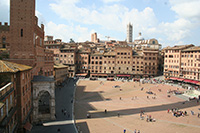![]()
Palazzo Pubblico
The Siena Duomo
Ospedale Santa Maria della Scala
Palazzo Piccolomini | Archivio di Stato di Siena
Basilica dei Servi
Some of the best Restaurants in Siena
Food shopping addresses in Siena
L’Orto de’Pecci
The Palio
Foundation of Siena
Sienese School of Painting
Fonti di Siena
The Siena area
Album Palio di Siena
Video Palio di Siena




